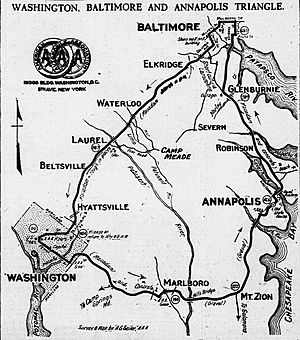Baltimore riots of 1919 facts for kids
| Part of Red Summer | |

Map of the Washington, Fort Meade, Baltimore and Annapolis
|
|
| Date | Summer of 1919 |
|---|---|
| Location | Baltimore, United States |
| Participants |
|
The Baltimore riots of 1919 were a series of difficult events that happened in Baltimore, Maryland. These events were part of a larger period known as the Red Summer of 1919. During this time, many African-Americans moved from the southern United States to northern cities for jobs. As more Black families moved into areas where mostly white people lived, tensions grew. Sometimes, these tensions led to serious conflicts and unrest.
Contents
What Caused the Baltimore Riots of 1919?
In the early 1900s, many African Americans moved from the South to northern cities. This was part of a big movement called the Great Migration. They were looking for better jobs and a new life. When they arrived in cities like Baltimore, they often moved into neighborhoods that were mostly white. This change in how neighborhoods looked sometimes caused problems. It led to more tension between different groups of people. Sadly, this tension could sometimes turn into fights and riots.
The July 1919 Incident
One of the first incidents in Baltimore happened on July 11, 1919. Reports from that time mention a small riot taking place. Details about this specific event are not widely known. However, it was one of many similar events across the country that summer.
The October 1919 Incident
Another riot in Baltimore happened late at night on October 1, 1919. It continued into the early hours of October 2. This was near the end of the difficult "Red Summer" period. A small group of soldiers from Fort Meade was walking near Eastern Avenue and Spring Street. Someone threw a bottle from a house, and it hit one of the soldiers.
The soldiers started yelling at the Black residents in the area. They dared them to leave their homes. People worried that a bigger fight would start. The Baltimore police were called to the scene. They made the soldiers leave the area to calm things down.
About an hour later, the soldiers came back. This time, there were many more of them, perhaps fifty or sixty. They began shooting at any Black person they saw. When the police arrived again, they tried to stop the soldiers. More police officers were called to help. Four soldiers were arrested, and the others left.
However, the soldiers returned about half an hour later. They came in even larger numbers and moved quickly along Eastern Avenue. The police met them with heavy clubs. Two more soldiers were arrested, and finally, order was restored. The six arrested soldiers later had to pay small fines.
What Happened After the Riots?
The events in Baltimore were part of many similar conflicts that happened during the "Red Summer" of 1919. This summer saw attacks on Black communities in over thirty cities and counties across the United States. In most cases, large groups of white people attacked Black neighborhoods.
However, in some cities like Chicago and Washington, D.C., Black community groups fought back to protect themselves. Many people died during these events. For example, in the Elaine Race Riot in Arkansas, hundreds of Black people were killed.
Other major riots that year included the Chicago Race Riot and the Washington D.C. race riot. These events caused many deaths and injuries. They also led to a lot of damage to homes and businesses. The Red Summer showed how much racial tension existed in the United States at that time.
See also
 In Spanish: Disturbios raciales de Baltimore de 1919 para niños
In Spanish: Disturbios raciales de Baltimore de 1919 para niños

